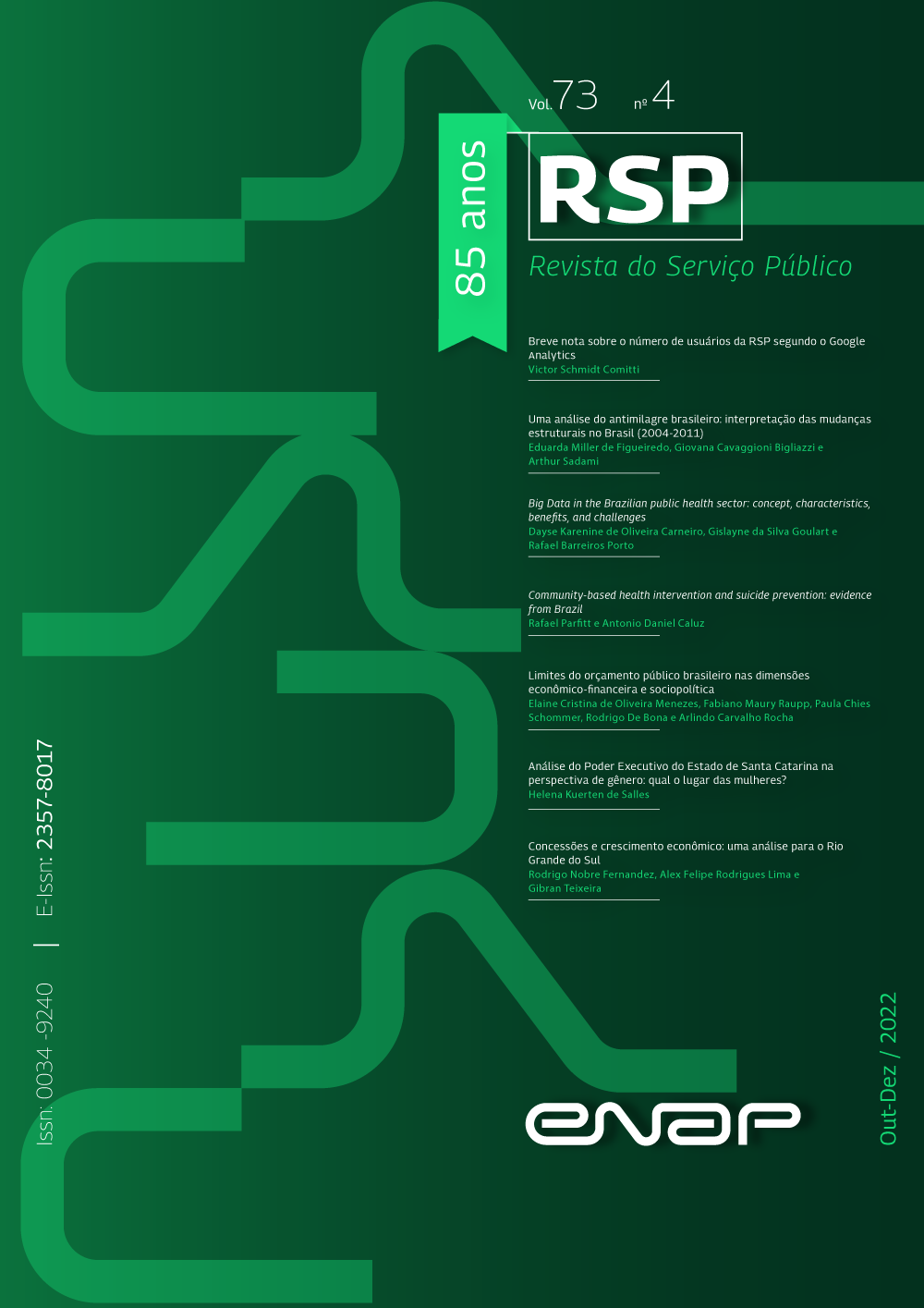Community-based health intervention and suicide prevention
evidence from Brazil
Keywords:
community-based interventions, suicide prevention, Family Health ProgramAbstract
This paper evaluates the impact of a community-based intervention on suicide prevention. To do so, we exploit heterogeneity in the program’s implementation across time, allowing us to investigate the program’s effect using an event study. We focused on the Family Health Program, which aims to provide primary health care to the population. We perform our analysis using municipality panel data. We employ a Difference-in-Differences strategy to assess the causal effect of the program. Our results indicate that FHP has a strong negative impact on suicide mortality rates and this effect is monotonic with the exposition time, especially in middle-aged individuals. Also, we found that more prolonged exposure to the program reduces suicide among women at younger ages. However, results indicate that the program is associated with increased hospitalization self-inflicted injuries rate in elderlies. We discuss different potential mechanisms for differential impacts by age and sex.
Downloads
References
Abadie, A., Athey, S., Imbens, G. W., & Wooldridge, J. (2017). When should you adjust standard
errors for clustering? Technical report, National Bureau of Economic Research.
Alvarez, Ariadna Patrícia Estevez; Vieira, Ágata Carla de Deus & Almeida, Fayllane Araujo. (2017).
Núcleo de Apoio à Saúde da Família e os desafios para a saúde mental na atenção básica. Physis. v. 29(4).
DOI: 10.1590/s0103-73312019290405.
Anderson, S. & Genicot, G. (2015). Suicide and property rights in india. Journal of Development
Economics, 114: 64–78.
Andrews, J. A. & Lewinsohn, P. M. (1992). Suicidal attempts among older adolescents: Preva- lence
and co-occurrence with psychiatric disorders. Journal of the American Academy of Child & Adolescent
Psychiatry, 31(4):655–662.
Bangs, Mark E. et al. (2014). Meta-analysis of suicide-related behavior or ideation in child, adolescent,
and adult patients treated with atomoxetine. Journal of child and adolescent psychopharmacology, v. 24,
n. 8, p. 426-434.
Becker, G. S. (1965). A theory of the allocation of time. The economic journal, p. 493–517.
Bertrand, M., Duflo, E., & Mullainathan, S. (2004). How much should we trust differences-indifferences
estimates? The Quarterly journal of economics, 119(1):249–275.
Bhalotra, S. R., Rocha, R., & Soares, R. R. (2019). Does universalization of health work? evidence
from health systems restructuring and maternal and child health in brazil. Technical report, ISER
Working Paper Series.
Brasil. (2010). https://bvsms.saude.gov.br/bvs/publicacoes/memorias_saude_familia_brasil.pdf and
https://bvsms.saude.gov.br/bvs/publicacoes/diretrizes_do_nasf_nucleo.pdf.
De Macedo, Ethiara Vieira, & Camargos, Mirela Castro Santos. (2021). Avaliação da Rede de Atenção
Psicossocial: Análise da cobertura dos CAPS em Minas Gerais. RAHIS-Revista de Administração
Hospitalar e Inovação em Saúde, v. 18, n. 3, p. 1-21.
Dias, M. & Fontes, F. (2020). The effects of a large-scale mental health reform: Evidence from Brazil.
WP: IEPS..
Fedden, R. (1938). Suicide: a social and historical study.
Funk, M., Drew, N., & Knapp, M. (2012). Mental health, poverty and development. Journal of public
mental health.
Grossman, M. (1972). On the concept of health capital and the demand for health. Journal of Political
economy, 80(2):223–255.
Hamermesh, D. S. & Soss, N. M. (1974). An economic theory of suicide. Journal of Political Economy,
(1):83–98.
Hegerl, U., Rummel-Kluge, C., Värnik, A., Arensman, E., & Koburger, N. (2013). Alliances against
depression: A community-based approach to target depression and to prevent suicidal behaviour.
Neuroscience & Biobehavioral Reviews, 37(10):2404–2409.
Kim, H. F. S., Braun, U., & Kunik, M. E. (2001). Anxiety and depression in medically ill older adults.
Journal of Clinical Geropsychology, 7(2):117–130.
Knox, K . L., Pflanz, S., Talcott, G. W., Campise, R . L., Lavigne, J. E., Bajorska, A ., Tu, X ., &
Caine, E. D. (2010). The us air force suicide prevention program: Implications for public health policy.
American journal of public health, 100(12):2457–2463.
Lebenbaum, M., Cheng, J., de Oliveira, C., Kurdyak, P., Zaheer, J., Hancock-Howard, R., &
Coyte, P. C. (2020). Evaluating the cost effectiveness of a suicide prevention campaign implemented in
Ontario, Canada. Applied health economics and health policy, 18(2):189–201.
Murphy, G. E. (1998). Why women are less likely than men to commit suicide. Comprehensive
psychiatry, 39(4):165–175.
Oyama, H., Sakashita, T., Ono, Y., Goto, M., Fujita, M., & Koida, J. (2008). Effect of communitybased
intervention using depression screening on elderly suicide risk: a meta-analysis of the evi- dence
from japan. Community Mental Health Journal, 44(5):311–320.
Parfitt, R., Costa, G. W., & Hellwig, F. (2019). Impact of the Brazilian family health strategy on
sexual and reproductive health outcomes: An analysis at individual and population levels. Encontro
Nacional de Economia - ANPEC, 2019, São Paulo.
Rocha, R. & Soares, R. R. (2010). Evaluating the impact of community-based health interventions:
Evidence from Brazil’s family health program. Health Economics, 19(S1):126–158.
Rockett, Ian RH; Caine, Eric D. (2015). Self-injury is the eighth leading cause of death in the United
States: It is time to pay attention. JAMA psychiatry, v. 72, n. 11, p. 1069-1070.
Turecki, Gustavo; Brent, David A. (2016). Suicide, and suicidal behaviour. The Lancet, v. 387, n.
, p. 1227-1239.
Wong, P. W., Chan, W. S., Chen, E. Y., Chan, S. S., Law, Y., & Yip, P. S. (2008). Suicide among adults
aged 30–49: A psychological autopsy study in hong kong. BMC Public Health, 8(1):147.
Downloads
Published
How to Cite
Issue
Section
License
Copyright (c) 2022 Revista do Serviço Público

This work is licensed under a Creative Commons Attribution-NonCommercial-ShareAlike 4.0 International License.
- A RSP adota a licença Creative Commons (CC) do tipo Atribuição – Uso Não-Comercial (BY-NC).
- A licença permite que outros remixem, adaptem e criem obra licenciada, sendo proibido o uso com fins comerciais.
- As novas obras devem fazer referência ao autor nos créditos e não podem ser usadas com fins comerciais, porém não precisam ser licenciadas sob os mesmos termos dessa licença.
- Ao publicar o artigo na RSP, o autor cede e transfere para a ENAP os direitos autorais patrimoniais referentes ao artigo.
- O artigo publicado na RSP não poderá ser divulgado em outro meio sem a devida referência à publicação de origem.
- O autor que tiver o artigo publicado na RSP deverá assinar o Termo de Concessão de Direitos Autorais (em momento oportuno a editoria da Revista entrará em contato com o autor para assinatura do Termo).



